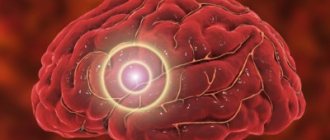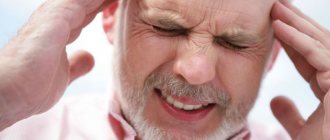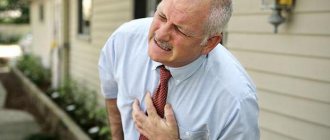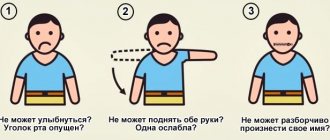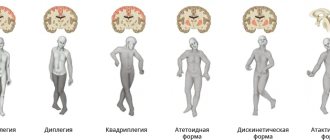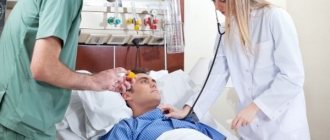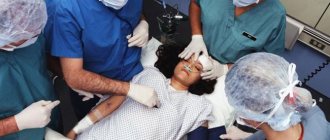Stroke: types, signs, prevention
28.06.2019
Stroke is an acute disorder of cerebral circulation due to blockage of blood vessels or their rupture. After a vascular accident, neurological symptoms develop within a few minutes or hours, which progress, sometimes leading to death. Recently, cases of stroke have become more frequent at young ages, up to 30 years.
Kinds
The main classification of strokes (according to ICD-10) takes into account the cause and mechanism of stroke.
- An ischemic stroke is characterized by a cessation of blood flow to the brain tissue. The reason is a violation of blood flow, blockage of an artery with a blood clot and/or narrowing by an atherosclerotic plaque (atherothrombotic), vasospasm, and a decrease in pressure. Most often develops at the age of 50-69 years. The incidence is 64-75% among all types of stroke.
- Hemorrhagic stroke is a hemorrhage into the substance of the brain or under the arachnoid membrane due to rupture of a vessel as a result of high blood pressure, atherosclerosis, vasculitis, aneurysms, coagulation disorders. Patients aged 50-69 years are at high risk. At 39-49 years old it is less common. The incidence is 15-20% among all types of stroke.
There are classifications that distinguish types of stroke taking into account other signs.
1. By severity:
- minor, including microstroke (transient ischemic attack) - a passing disturbance of cerebral circulation with complete disappearance of neurological symptoms within 1 day to 3 weeks;
- moderate severity;
- severe, extensive stroke of the brain - damage to a large area with pronounced neurological symptoms and severe condition, sometimes with falling into a deep coma.
2. By location
- left or right hemisphere. Each side is responsible for different functions, so the symptoms will be different. For example, if the left half is affected, the movements of the right side of the body suffer, speech and memory are impaired. The person loses the ability to read and write.
When the right hemisphere is damaged, the movement of the left side of the body, the perception of oneself, one’s body, and the surrounding space are impaired, and mental disorders develop.
3. By quantity
- primary stroke (first) and repeated strokes (second, third, fourth). Repeated strokes are more severe because the lesion area increases each time.
4. By age
- in children, starting from the prenatal period, young, elderly. The severity of clinical manifestations and prognosis depend on the patient’s age, the cause of concomitant pathology, and the timeliness of diagnosis. The most difficult prognosis is for delayed detection of a stroke, a large lesion, a weakened body due to concomitant diseases, bad habits, and vitamin deficiency.
5. By localization
:
- in the vertebrobasilar basin with damage to the occipital lobe of the brain, cerebellum and brainstem - visual disturbances develop, gait changes;
- frontal lobes - speech and swallowing suffer;
- temporal lobes - memory, writing, speech deteriorate;
- parietal lobe - speech and speech understanding suffer.
Causes of stroke.
There can be several causes of stroke. The main and most common cause of stroke is hemorrhage in the human brain. That is, a vessel or vein in the brain bursts, resulting in hemorrhage and death of a part of the brain. A blood clot can also cause a stroke. But the above reasons are the result of the patient’s life. For example, you work at a job with heavy load (physical or mental). And for several years you don’t take a vacation and work without rest. And subsequently, accumulated fatigue and overstrain in the brain bursts a vessel. People who abuse alcohol can also have a stroke. Poor nutrition and lack of vitamins can also result in a stroke. These are just some of the causes of stroke. More detailed information can be obtained from the video at the end of the article.
Ischemic stroke
Development and risk groups
The development of a stroke is caused by a sharp increase in blood pressure, physical activity, and emotional stress. In such situations, a vessel ruptures followed by hemorrhage or spasm with ischemia. Predisposing factors are diabetes mellitus, high cholesterol, heart, vascular and blood diseases, and excess weight. In these diseases, blood vessels lose their elasticity and their walls stretch. People who or their close relatives have had a stroke or heart attack should be especially careful.
There are scales that determine the degree of risk of developing a stroke: the Framingham scale for assessing individual risk of developing stroke, the London School of Hygiene questionnaire on cardiovascular diseases by J. Rose.
By undergoing such testing, you can identify the degree of risk, undergo an examination and undergo a course of treatment in a timely manner before your health is affected.
Risk groups are identified:
- by age and gender - the likelihood of a stroke increases after 30 years. Ischemic stroke occurs more often in men aged 50-69 years. The incidence of hemorrhagic stroke up to 60 years of age is the same in men and women, then higher in women;
- in terms of lifestyle - unfavorable factors include inactivity, bad habits, stress, heavy physical labor. These factors worsen health and provoke chronic heart and vascular diseases.
Treatment and rehabilitation
The acute condition of hemorrhagic stroke is treated as follows:
- treatment in intensive care;
- intensive therapy up to 2 months;
- administration of drugs that improve blood clotting;
- according to indications – surgical removal of the hematoma.
Important! In the case of a stroke, the speed of the measures taken is important - the start of treatment no later than 3 hours after the onset of the clinical picture of the disease.
Treatment of stroke of ischemic etiology:
- immediate hospitalization in the intensive care unit;
- stay in the intensive care unit for up to 2 months;
- administration of drugs that promote vasodilation, as well as agents that stimulate general blood flow and reduce blood clotting;
- according to indications - surgical intervention to remove a blood clot.
Rehabilitation begins in the intensive care unit; after the patient is discharged, the process continues at home. It may take six months to recover from an ischemic type of illness, and a year to a year and a half for hemorrhagic illness.
First signs and symptoms
Before a stroke, drowsiness, headache, numbness of the limbs, fatigue, spots before the eyes, nausea, dizziness, temperature fluctuations, and blood pressure jumps appear. These are the harbingers or first signs of a stroke that appear several hours or days before the disaster. Most often, these symptoms are ignored, or they are attributed to fatigue and overwork.
Symptoms of a stroke themselves are divided into general cerebral and focal. They can be of varying degrees of severity depending on the prevalence of the pathological process.
- General cerebral symptoms: headache, impaired consciousness up to loss of consciousness, stupor, agitation or weakness, disorientation in space and time, sweating, feeling hot, convulsions. Makes you feel sleepy and sometimes chills.
- The focal abnormalities of a stroke depend on which area of the brain is affected. They can be unilateral or bilateral. This group includes disturbances in speech, vision (visual hallucinations), gait, movements up to paralysis, and sensitivity.
Symptoms of ischemic cerebral stroke develop gradually, with focal symptoms predominant.
With a hemorrhagic stroke, the onset is rapid, with a predominance of cerebral symptoms.
There are several stages in the development of a stroke: the acute period (from the moment of the stroke to 3 weeks on average), the recovery period - from 2 weeks to 24 months.
What does a stroke look like in people? Photos
A stroke in people looks like a loss of consciousness, a pre-fainting state, but the disorders in the brain are more serious than with normal fainting. Symptoms of a stroke do not appear suddenly - usually a person feels characteristic signs of deteriorating health, but few people know that a deterioration in health will be followed by the development of a stroke. The first signs of a stroke appear in the form of sudden weakness, dizziness, sharp pain in the head, and visual disturbances. Following these symptoms, in stroke victims, the pulse slows down, blood rushes to the face, cold sweat appears on the forehead, speech or motor activity is impaired, like a myocardial infarction, a stroke can provoke numbness of the limbs or part of the body.
Sometimes the brain is affected by a microstroke (photo in gal.) - it is also called transient ischemic attacks. Signs of a micro-stroke may not be so noticeable, so patients complain only of minor deterioration in health - dizziness, spots in the eyes, weakness, pre-syncope, which does not always end in fainting. A facial stroke develops in the form of muscle paresis of one side.
What to do if you have a stroke
There are techniques that allow you to identify signs of a stroke yourself. For example, they can be used if someone becomes ill on the street and you suspect a stroke. You need to ask the person to smile, speak, raise both hands. If the victim cannot comply with your request or there is asymmetry, you should immediately call for help and list all the symptoms.
At the same time, you need to provide first aid: lay the victim down, placing a small support under his head, and free him from clothes that are preventing him from breathing. He should not eat or drink or make sudden movements. When vomiting, turn your head to the side.
Further treatment is carried out in a hospital. First, diagnostics are carried out to clarify the diagnosis; computed tomography and magnetic resonance imaging, lumbar puncture and EEG (echoencephalography), angiography are prescribed. Then conservative (basic therapy, treatment of neurological complications) or surgical treatment is prescribed.
After the end of the acute period, rehabilitation is prescribed: massage, physical therapy and other activities, depending on the degree and type of disorder. The patient is observed by a neurologist, physiotherapist, speech therapist, and psychotherapist.
The brain has neuroplasticity: with the right approach, you can recover from a stroke, restore brain function and prevent stroke complications. The key factor is timely initiation of treatment, proper rehabilitation and regular exercise.
According to WHO, about 60% of patients do not require assistance by the end of the first year, and 30% of patients of working age can return to work.
Is it possible to do an MRI after a stroke?
Magnetic resonance imaging is not a contraindication for stroke if the patient's condition is stable and does not require intensive care and resuscitation measures, such as artificial ventilation. Moreover, the use of MRI in the diagnosis of acute cerebrovascular accidents makes it possible to clarify the diagnosis, identify the presence of blood clots, atherosclerotic plaques, and detect the source of hemorrhage. However, if the patient's condition is unstable and requires intensive care, magnetic resonance imaging must be abandoned in favor of the less accurate but faster computed tomography.
Magnetic resonance imaging for stroke is used not only for diagnosis, but also to assess the dynamics of recovery of the affected part of the brain after several days, weeks and even months. The method is ideal for this purpose, since computed tomography cannot be used with such frequency due to radiation exposure, and is inferior in accuracy to MRI.
Prevention
- Primary prevention consists of proper nutrition, exercise, giving up bad habits and stress, adequate sleep and rest, and regular medical examinations.
- Secondary prevention of stroke includes the elimination of risk factors - treatment of concomitant pathologies, regular monitoring by the attending physician, elimination of risk factors. This approach will help not only prevent stroke, but also improve overall health. According to WHO estimates, the creation of an adequate system of care for patients with stroke will make it possible in the coming years to reduce mortality during the 1st month of the disease by 20% and ensure independence in everyday life 3 months after its onset in at least 70% of patients.
Surgical treatment of hemorrhagic stroke
Hemorrhagic stroke is a serious disease that requires immediate medical attention. One of the tasks of the “Special Medical Assistance” advisory service is to provide all stages of treatment for hemorrhagic stroke.
A hemorrhagic stroke is a bleeding in the brain, most often caused by high blood pressure. Unfortunately, about half of all cases of this disease in the acute period end in death, and more than 2/3 of survivors become disabled. The outcome depends primarily on the timeliness of medical care.
Modern surgical treatment for hemorrhagic stroke
Only in specialized centers is it possible to conduct a thorough diagnosis and adequate surgical or therapeutic treatment of hemorrhagic acute stroke. However, most often a free ambulance will take the victim to the nearest city hospital, where first aid will be provided, limited by the capabilities of the institution. And surgical treatment of stroke, unfortunately, can not be performed in all hospitals.
Therefore, relatives of patients are increasingly turning to specialized advisory services that can provide:
- safe transportation;
- rapid hospitalization;
- expert monitoring of victims in intensive care units and departments of medical institutions.
Only in highly qualified centers will they conduct the necessary research, assess all the risks, and then choose the necessary treatment tactics.
Another important point that affects the patient’s further capacity is rehabilitation and care after surgical treatment of hemorrhagic stroke. The success of postoperative therapy largely depends on the experience of specialists and the availability of modern equipment.
Indications and contraindications for surgical treatment of stroke
Not all cases of hemorrhagic stroke require aggressive management. Examination by specialists and data from instrumental diagnostic methods allow an adequate assessment of the patient’s general condition.
Contraindications to surgical treatment of stroke are:
- severe concomitant diseases;
- old age over 65-70 years;
- large volume of hematoma;
- depressed consciousness - coma.
Depending on the indications, our consultants will be able to select the best specialized hospital for the victim.
FAQ
How is a stroke different from a heart attack?
Cerebral infarction is one of the types of stroke and it is ischemic in nature, i.e. accompanied by a cessation of blood flow to the brain. A characteristic feature is the gradual development of the clinical picture and the predominance of focal symptoms: disturbances in speech, vision, gait, movements up to paralysis, sensitivity.
Can a stroke and heart attack happen at the same time?
If we consider only the brain, mixed stroke occurs, when the causes of stroke include both hemorrhage and ischemia. They can occur simultaneously when a vessel ruptures in one area and blood flow stops in another. Also, ischemia can develop at the site of subarachnoid hemorrhage after some time.
If we consider a heart attack as a heart disease, then these conditions can also be diagnosed simultaneously. Moreover, a stroke can develop as a result of a heart attack: the functioning of the heart suffers, and insufficient blood flows to the brain. This is how we get a stroke.
Does a stroke only occur in the brain?
Stroke (Latin insultus “swoop, attack, blow”) is an acute disruption of the blood supply to the brain due to ischemia (infarction) or hemorrhage. If ischemia occurs in other organs, it is also called a heart attack. For example, myocardial infarction, intestinal, kidney, etc. It is characterized by severe pain, dysfunction of the affected organ and other symptoms.
Does stroke occur with normal or low blood pressure?
Arterial hypertension is one of the main, but not the only causes of stroke. Thrombosis, atherosclerosis, and diabetes mellitus, in which blood pressure is normal or even reduced, are also risk factors. In addition, with low pressure, the brain is not sufficiently supplied with oxygen, which is a prerequisite for the development of ischemic stroke.
Do children have strokes?
Stroke is also diagnosed in children. It can develop even in the perinatal period. Causes: abnormalities in the coagulation system, pathologies of the cardiovascular system, including vascular malformations, bad habits of the mother during pregnancy, oxygen starvation during childbirth, trauma.
In the perinatal period and up to one year, the disease is accompanied by anxiety, frequent crying, loss of appetite, impaired reflexes in the newborn period, strabismus, and convulsions. The diagnosis is made based on an examination by a pediatric neurologist, ultrasound of the brain, and tomography results. At older ages, symptoms are similar to those of stroke in adults.
The child's body is more flexible and responds more quickly to therapy. The main thing is to diagnose a stroke in time and begin treatment.
Can a stroke go away on its own?
There is such a condition - transient stroke. It is accompanied by a short-term circulatory disorder, but no irreversible changes in brain tissue occur. The external manifestations of such a stroke are the same as a normal one, but less pronounced: headache, dizziness, darkening of the eyes, changes in sensitivity in various parts of the body. And they pass within 24 hours. However, the condition requires qualified treatment and rehabilitation, elimination of risk factors, because in the future there is a possibility of a secondary stroke.
At what pressure can a stroke occur?
A stroke can develop at any pressure. Arterial hypertension causes hemorrhagic stroke, hypotension causes ischemic stroke.
Do pine cones help prevent stroke?
Pine cones lower blood pressure, so they should not be consumed if you have hypotension. The effect is due to the tannins contained in the buds. The composition also contains vitamins C and P - they strengthen the walls of blood vessels and improve blood circulation.
The advisability of using products based on herbal raw materials is decided by the attending physician after a detailed examination. In general, pine cones for stroke can only be used as a complementary method.
Therapy methods
If any type of stroke is suspected, a person is urgently hospitalized for emergency medical care. Only a third of patients with damage to the brain stem survive the stroke, and even for them the prognosis for recovery after a brain stem stroke is unfavorable.
Surgical intervention
The hemorrhagic form of the pathology often leads to death. Therefore, if this type of stroke is suspected, brain surgery is performed urgently.
Cranial trephination helps eliminate hemorrhage in the shortest possible time, this allows you to quickly reduce the pressure inside the skull.
When diagnosing an ischemic type of stroke, a thrombolytic is injected into the affected area. The manipulation is accompanied by drilling of the skull.
Local administration of the drug accelerates the resorption of blood clots. This procedure is not performed for vascular diseases and the presence of aneurysms.
Pharmacological treatment
For ischemic stroke, drug therapy is usually limited. The patient is prescribed drugs that combat cerebral swelling, normalize blood pressure, and restore nutrition to tissue structures.
In case of hemorrhage, the victim takes anticoagulants and thrombolytics. Intravenous medications to stop bleeding may be required. As symptomatic therapy, the patient is prescribed antibacterial medications. Such patients are fed through a special tube.
Possible consequences
After the acute stage of pathology is eliminated, the following consequences may develop:
- Loss of motor ability - paralysis, loss of the ability to move the upper and lower limbs, sometimes a pathological reflex is observed. According to statistics, such changes are observed in 80% of cases;
- Impaired visual perception - the image may be distorted, in some cases vision disappears completely;
- Impaired speech function - option 1 - the patient loses the ability to speak, read and write, but perceives the interlocutor’s speech adequately. Option 2 – the patient does not understand someone else’s speech, his own speech is lost or becomes incoherent;
- Cerebellar dysfunction - dizziness appears even at rest, vomiting for no reason, blood pressure rises, and heart rate increases.
Who takes more risks?
Signs of a microstroke occur mainly in people whose blood vessels have already been damaged by some pathological process. This happens when:
- atherosclerosis;
- congenital changes in the structure of blood vessels;
- diabetes mellitus, which leads to changes in the structure of the vascular wall;
- increased blood pressure due to various reasons;
- heart diseases: myocardial infarction, arrhythmias, endocarditis, heart defects. This increases the risk of thrombosis;
- after heart surgery (associated with the formation of a blood clot and its entry into the cerebral artery system);
- taking tablet contraceptives, which increase the risk of thrombosis;
- smoking or frequent drinking of alcohol, leading to vasospasm;
- migraine, in which the regulation of vascular tone is disrupted;
- inflammation of the blood vessels of the brain (vasculitis), which may be infectious or autoimmune in nature;
- compression of the arteries supplying the brain in the cranial cavity or in the neck with: osteochondrosis or spondylosis of the cervical spine, intracranial or neck tumor;
- aneurysms of the arteries of the brain, when dilated areas appear in them in which blood clots can appear;
- vegetative-vascular dystonia, one of its variants, when the coordinated command of vascular tone on the part of two parts of the autonomic nervous system is disrupted;
- varicose veins of the venous bed of the legs: dilated vessels with low blood flow speed are a favorite place where blood clots form;
- overweight: adipose tissue, especially in the abdominal area, is itself an endocrine gland. It produces estrogens, the excess of which increases the risk of blood clots;
- constant heavy physical activity, which affects vascular tone;
- chronic stress acting on the hypothalamus - an endocrine organ in the cranial cavity, commander, including the autonomic nervous system;
- diseases of the blood coagulation system, when the tendency to thrombosis increases;
- Fabry disease is a hereditary disease in which special molecules, sphingolipids, are deposited in vascular cells. This reduces the diameter of the arteries.
The more risk factors one person has, the higher the chance of developing a vascular accident.
The risk of developing a microstroke (and stroke) increases after 30 years; from 60 it doubles. This is due to a slowdown in metabolic processes, including in the vascular wall. As a result, the diameter of the arteries (including the brain ones) usually decreases. In addition, the vessels begin to respond less well to commands to expand and contract coming from the nervous system.
Don't miss the first signs of a stroke
Hundreds of thousands of cases of stroke are recorded annually in civilized countries. Unfortunately, if you “skip” the first minutes and hours of this terrible disease, the process becomes irreversible... That is why it is so important to know the rules of first aid for a stroke
When does a stroke occur?
A stroke occurs when the lumen is blocked or the wall of a vessel located in the brain is ruptured.
A stroke can be ischemic (when a blood clot completely blocks the lumen of a blood vessel) and hemorrhagic (when the wall of an artery that supplies blood to one or another part of the brain ruptures, a hematoma is formed).
In this case, naturally, the normal blood supply is disrupted and the death of brain cells begins. The process of damage to brain structures can develop extremely rapidly, and the longer a person does not receive proper medical care, the more irreversible changes occur.
What causes a stroke
There is no single cause of stroke, so it is customary to talk about a set of risk factors that can lead to stroke. First of all, this is, of course, heredity.
If a person has “weak” vessels (that is, there is a genetically determined weakness of the connective tissue), he may develop an aneurysm (an expansion or dissection of the wall of the vessel supplying the brain), which, having reached a certain size, can “rupture” and a hemorrhagic stroke will occur. If a person has a tendency to accumulate “bad” cholesterol, then atherosclerotic plaques will form in his vessels, narrowing the lumen and promoting the formation of blood clots. Risk factors such as smoking, hypertension, arrhythmia, excess weight and diabetes mellitus also work. Therefore, no one can feel insured against a stroke.
Learn the rules of stroke
“Why do I need them,” you say, “I’m a completely healthy person, and my circle of relatives and friends includes young people full of vitality.” Unfortunately, stroke is rarely interested in the age of the person it comes to.
Of course, men over 45 years of age and women over 55 years of age are at risk, but today cases of stroke are not uncommon in both 30-year-olds and those who have just turned 25.
Moreover, the younger the person, the less expected the signs characteristic of a stroke may be, and therefore, the longer he will remain without help, and the sadder the consequences of a brain catastrophe may be.
Symptoms of a stroke tend to develop very quickly. The scenario is approximately the same, only the sequence of their occurrence can change. Usually a person begins to have an attack of a sharp, unbearable headache, he complains that his head is literally “tearing apart.”
The gait may change, it becomes unstable, the person falls, or paresis (numbness) of the muscles of the limbs or face may begin. A stroke is characterized by unilateral paresis, when muscle weakness appears only on the left or right side of the body.
Because of this, the patient’s mouth seems to “distort” and even facial features change. Speech becomes less clear - or slows down, or, conversely, the person begins to speak very quickly, but incomprehensibly.
There may also be fog before the eyes, unfocused gaze, and it becomes difficult for the patient to formulate his thoughts and choose words.
Doctors recommend remembering three basic techniques for recognizing stroke symptoms: SMILE - SPEAK - RAISE YOUR HANDS (UP)
- Ask the person to SMILE. With a stroke, the smile turns out to be “crooked”, since the muscles on one side of the face are much less responsive.
- TALK to him and ask him to answer a simple question, such as: “What is your name?” Usually, at the moment of a brain catastrophe, a person cannot even pronounce his own name coherently.
- Invite him to RAISE BOTH HANDS at the same time. As a rule, the patient fails to cope with this task; the arms cannot rise to one level, since one side of the body obeys worse.
What to do next?
Urgently, without delay, call an ambulance. If this is not possible, take the patient to the nearest hospital or medical center yourself.
But very, very quickly! There is no need to wait for anything, much less be fooled by the victim’s words that “everything will pass now.”
If this is a stroke, then nothing will go away, the patient will get worse, he may die or remain deeply disabled for life! Before the ambulance arrives (or while you are taking the victim to the hospital), you need to do the following:
- lay him down so that his head is higher than his body, provide access to fresh air (open a window, if impossible, take the patient out of the stuffy room to the street), remove all restrictive clothing (collars, cuffs, belt);
- Place 10 glycine tablets under your tongue at once. Attention! Not to be confused with nitroglycerin (it is contraindicated in cerebral accidents!!!!), namely Glycine®, a drug proven to improve cerebral circulation. Since 1999, glycine has been included in the equipment list of all ambulance teams, but the sooner the patient receives the drug, the better, so it is better if it is always in your office or home medicine cabinet;
- measure your blood pressure, most likely it will be elevated, so the person needs to be given a drug that he takes “for blood pressure” constantly (if this drug is prescribed to him by a doctor). If there is no medicine at hand, lower the patient’s feet into a basin of hot water;
- if vomiting begins, turn the patient's head to the side so that the vomit does not enter the respiratory tract. When the vomiting stops, try to give the patient glycine and its hypertension medicine again.
If after a set of these measures a person “feels better”, this does not mean that the stroke has passed.
It’s too early to relax, since all the symptoms described above could be signs of a transient (transient) ischemic attack (TIA), that is, the brain vessel was not completely blocked, but only partially. But such an attack at any moment can turn into a real stroke.
It can only be prevented by qualified medical actions, a high-quality examination of the cerebral vessels, which is only possible in the clinic, and, of course, adequate therapy for this condition.
NamePrice
| Primary appointment (examination, consultation) with a neurologist | 1 800 ₽ |
| Primary appointment (examination, consultation) with a neurologist, MD/Professor | 4 000 ₽ |
| Primary appointment (examination, consultation) with a neurologist, Ph.D. | 2 200 ₽ |
| Repeated appointment (examination, consultation) with a neurologist | 1 200 ₽ |
| Repeated appointment (examination, consultation) with a neurologist, MD/Professor | 2 500 ₽ |
| Repeated appointment (examination, consultation) with a neurologist, Ph.D. | 1 500 ₽ |
If you suspect a stroke, consult your doctor
Source: https://gkb81.ru/sovety/ne-propustite-pervye-priznaki-insulta/


